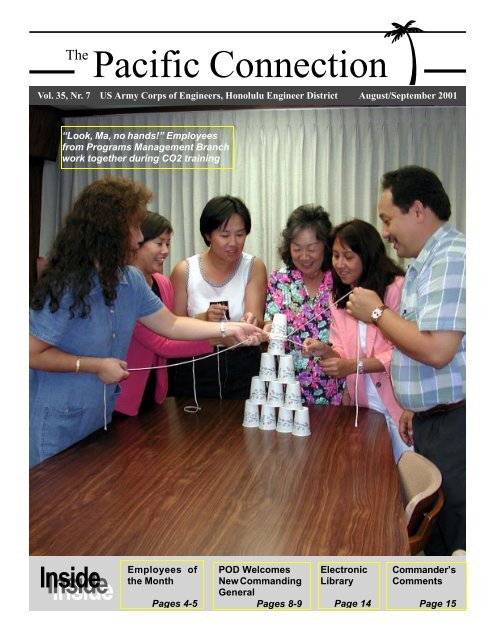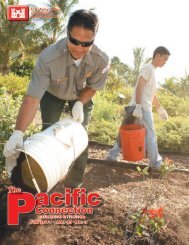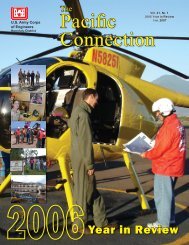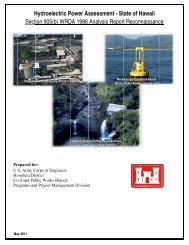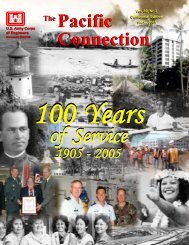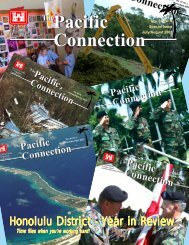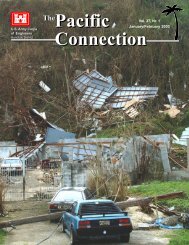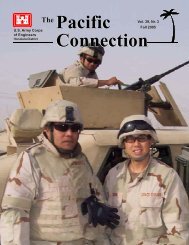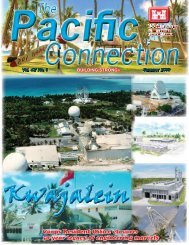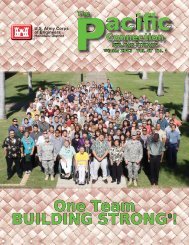Pacific Connection - Honolulu District - U.S. Army
Pacific Connection - Honolulu District - U.S. Army
Pacific Connection - Honolulu District - U.S. Army
- No tags were found...
Create successful ePaper yourself
Turn your PDF publications into a flip-book with our unique Google optimized e-Paper software.
The<strong>Pacific</strong> <strong>Connection</strong>Vol. 35, Nr. 7 US <strong>Army</strong> Corps of Engineers, <strong>Honolulu</strong> Engineer <strong>District</strong> August/September 2001“Look, Ma, no hands!” Employeesfrom Programs Management Branchwork together during CO2 trainingInsideInsideEmployees ofthe MonthPages 4-5POD WelcomesNew CommandingGeneralPages 8-9ElectronicLibraryPage 14Commander’sCommentsPage 15
2 The <strong>Pacific</strong> <strong>Connection</strong> August/September 2001Adversity:The finest steel has to go through the hottest fire. —Richard M. Nixon, 37th U.S. president<strong>District</strong> ict LeadershipHED Deputy delighted with assignmentMaj. Scott Schriner, HED Deputy CommanderStory and photograph by Alexander KufelMilitary life is different from that of civilians. PCS (permanentchange of station) orders can appear and disappearwith alarming rapidity and military families can find themselvesheaded for destinations they hardly considered. Six monthsbefore his July arrival in Hawaii for his new job as HED DeputyCommander, Maj. Scott Schriner, his wife Lisa, and their twosons Craig, 8, and Douglas, 5-1/2, were getting ready for a tourof duty at Fort Hood, Texas. Then, everything changed.“The prospect of living in Hawaii wasn’t even on our radarscreen last December,” said Schriner. Suddenly, in January theyfound themselves trying to find out about schools in Hawaiiinstead of Texas. They decided that Moanalua Elementaryseemed like a pretty good place to send their children, particularlysince it was close to Fort Shafter. For them, said Schriner,the quality of the house they would live in was secondary to thequality of education. That settled, all they had to do was findhousing nearby and they would be all set. Nobody told theSchriners that Moanalua Gardens was an area of very lowturnover so they weren’t even surprised when a rental unitThe <strong>Pacific</strong> <strong>Connection</strong>, an unofficial publication authorizedby AR360-1, is a monthly newspaper produced by thePublic Affairs Office, <strong>Pacific</strong> Ocean Division and <strong>Honolulu</strong>Engineer <strong>District</strong>, US <strong>Army</strong> Corps of Engineers, FortShafter, HI 96858-5440. Telephone (808) 438-9862. Thiscommand information newspaper is for employees andothers who request it in writing. Contents are not necessarilythe official views of, or endorsed by, the U.S.This newspaper is printedon recycled paper.Government, the Department of Defense or the Departmentof the <strong>Army</strong>. Circulation: approximately 1,300.became available just as they arrived.Now, a few weeks later, the Major is settling into his job,his family is settling into their new home and one discovers thatnearly 14 years of marriage and 14 years in the <strong>Army</strong> are not acoincidence at all. Instead, they represent the kind of clarity ofpurpose that goes along with knowing one’s self and making lifedecisions that support that vision.Schriner said that he likes to be involved in things, but nota lot of things at the same time.“I work hard at the things I do,” he said. “And I expect otherpeople to do their job. I don’t see any difference betweenmilitary and civilians, we all have a job to do.”Schriner completed graduate school while a projectengineer and assistant resident engineer at the Scott Air ForceBase resident office in Louisville <strong>District</strong> in 1998. From thenuntil June 2000 he was part of the 2 nd Training Support Battalion.Recently, he completed the year long Resident Command andGeneral Staff College course at Fort Leavenworth, Kan.“I’m very mobile,” he said. “I can go anywhere, but thehardest thing about coming to Hawaii was having to tear thefamily away from their friends. Lisa and I talk a lot. To be in the<strong>Army</strong> you really need a supportive spouse. We are already makingnew friends and that will get better with time.”Thus, his priorities are, for the moment anyway, focused onhis job and his family.Plans include becoming fully involved in the workings of the<strong>District</strong> while on the job. Off duty, he’s anticipating working withthe Cub Scouts, once Craig and Doug start again, and gettinginvolved in youth sports as an assistant coach, something he hasalready done for three years. Schriner said that he’s an avid golfer, isa huge NASCAR racing fan, and is temporarily separated from hisbaseball card collection. He also is looking forward to finding timeto go fishing again with his sons, something they haven’t yet beenable to do and teaching golf to them as well.Cover: Photographed in action during a recent CO2(Consideration of Others) training session, a team fromPrograms Management Branch consisting of Linda Tsugawa,Val Lee, Wendy Mow, Anne Chang, Renee Inouye and DeanFukuchi demonstrates its ability to work together toaccomplish a difficult task by quickly building a pyramid outof paper cups without using their hands. Or any other bodyparts, for that matter, they said. Also present but not picturedare Richard Raber, Geoff Lee, Craig Hashimoto, RandallWong and Doris Aguilar. —Photograph by Alexander Kufel.<strong>Pacific</strong> Ocean Division Commander.........................Brig. Gen. Ronald L. Johnson<strong>Honolulu</strong> Engineer <strong>District</strong> Commander.........................Lt. Col. Ronald N. LightChief, Public Affairs ...............................................................Douglas S. MaKittenPublic Affairs Specialist.................................................................Alexander KufelEditor .................................................................................................Michelle Cain
August/September 2001 The <strong>Pacific</strong> <strong>Connection</strong> 3Risk: If you don’t fail now and again, it’s a sign you’re playing it safe. —Woody Allen, actor/comedianHED’s Environmental Branchsupport helps keep <strong>Army</strong>’sPohakuloa Training Area openStory and photographs by Beth Miura,THED Environmental Branchraining is essential for military readiness and available land inthe state of Hawaii is scarce. That makes the <strong>Army</strong>’s remotePohakuloa Training Area on the Big Island of Hawaii vitally important.Support from the <strong>Honolulu</strong> Engineer <strong>District</strong> (HED)Environmental Branch ensures PTA complies with environmentalregulations and stays open so soldiers and other service memberscan train.“During a typical year we have 15,000-18,000 soldiers, marines,airmen and sailors training here,” said former PTA commanderLt. Col. Dennis Owen. “Our biggest customers are the <strong>Army</strong>’s 25 thInfantry Divisionand the 3 rd MarineRegiment atKaneohe, but all theother services andreserve componentsand even local lawenforcement unitstrain here, too.”PTA providesa combat trainingarea for full-scalelive fire and fieldtrainingexercises.The U.S. Air Force,U.S. Marines, andU.S. Navy also usethe impact area forbombing practice.The 108,000-acre installation isthe U.S. <strong>Army</strong> Garrison,Hawaii’slargest live fire range and training complex.PTA consists of three areas: cantonment, airfield, and training(which include approximately 54,000 acres of impact area). Withinthe training area, there are 22 live-fire ranges, seven airborne dropzones, 113 surveyed field artillery and mortar firing points and19,000 acres of maneuver area where platoon to brigade-sized unitsconduct combined arms, multi-echelon, and joint service exercises.Despite its remote location, which presents difficult transportationand logistical challenges, units come to Pohakuloa virtuallyyear round for something they can’t get anywhere else in Hawaii —room to train. PTA is the only military facility in Hawaii whereunits of 2,000-3,000 troops can train together at a single time.A key factor in keeping PTA available for training is ensuringthe installation is in compliance with environmental regulations.That responsibility lies with the U.S. <strong>Army</strong> Garrison, Hawaii,Directorate of Public Works (DPW) Environmental Division. DPWpartners with HED’s Environmental Branch. According to AlvinChar, chief of DPW’s Environmental Division, the <strong>Army</strong> takes veryseriously its responsibility to be good environmental stewards andminimize any damage to the land caused by soldiers, weapons, andequipment.Federal environmental compliance requirements are strict. Ifthe <strong>Army</strong> doesn’t comply, training can be stopped until correctivemeasures are taken. Should that happen, the impact on readinesscould be disastrous.PTA is locatedin the plateau area betweenMauna Kea andMauna Loa, the state’stwo tallest mountains,both more than 13,500feet high. At an elevationbetween 6,000-8,650 feet above meansea level, PTA is in themiddle of two differentclimate zones. A complexmosaic of plantcommunities has developedin this harshclimate, in the midst ofa heavily used trainingarea. To date, there arePrior to examining an area for endangered plant species, a team of environmentalspecialists uses a map to identify sector boundaries.11 federally listed endangeredand onethreatened listed plantspecies in PTA. Ofthose 12, three are found only at PTA.PTA is not only rich in flora but also fauna. Five federallylisted birds and one listed mammal species (the Hawaiian hoarybat) unique to the state of Hawaii are found there.In 1995, DPW’s Environmental Division developed a proactiveecosystem management program to enable military training tocontinue. Environmental Division requested HED’s support to implementthe ecosystem management because of the <strong>District</strong>’s experienceand expertise.During the past six years HED has awarded and managedSee “Pohakuloa,” page 12
August/September 2001 The <strong>Pacific</strong> <strong>Connection</strong> 5Intelligence:The intelligent man is one who has successfully fulfilled many accomplishments, and is yet willing tolearn more.—Ed Parker, martial artistEmployees of the MonthAnne ChangHometown: Ewa, HawaiiPosition with Corps and how long: Secretary, withCorps since 1988.Describe your job in 50 words or less: I serve asthe secretary for Programs Management Branchproviding clerical and administrative support to thebranch chief and other employees within Programsand Project Management Division (PPMD). I activelyparticipate in the organization by performingroutine administrative and miscellaneous clericalwork. I resolve problems associated with the administrativeand clerical work of PPM as they occur.What do you like best about your job? Every dayI look forward to interacting with people, especiallythe professionals in our Branch.What is the most difficult part of your job? I findit hard to wait for the information I need to meet mysuspense dates to come back to me before thedeadline.If I was the DE for a day, I would... give everyemployee who has not used their sick leave duringthe past year a day off.What is the best improvement in the <strong>District</strong> inthe past six months? The best improvement in the<strong>District</strong> is the new modular furniture. It looks verynice.What is the best improvement in your office inthe past six months? I did get a new computer andI’m happy about that. But, I still did not receive mynew furniture.Michael OnumaHometown: Pearl City, HawaiiPosition with Corps and how long: Mechanical Engineerin Design Branch since 1999.Describe your job in 50 words or less: I design airconditioning, plumbing and fire protection systems. Partof the process entails coordinating with others; calculatingsuch things as the cooling/heating loads, the cold/hotwater demand, the fire sprinkler demand, and sizing pipesand ducts; designing the controls for the mechanicalsystem; and sizing and specifying the mechanical equipment.What do you like best about your job? I know I will learnsomething new each day. Whether it’s something simple,such as learning a shortcut on CADD, or complex, such aslearning how a mechanical system functions, I enjoylearning new things.What is the most difficult part of your job? The mostchallenging aspect of my job is to balance the wants andneeds of the customer while still meeting suspense datesand budgets.If I was the <strong>District</strong> Engineer for a day, I would... thankeveryone for the hard work and dedication they put in tomake HED the best place to work.What is the best improvement in the <strong>District</strong> in thepast six months? The best improvement in the <strong>District</strong> isthe new modular furniture.What is the best improvement in your office (workgroup) in the past six months? I like the new CADDlaser plotter. It can hold two rolls of different sized paper,it’s fast and it doesn’t break down.
August/September 2001 The <strong>Pacific</strong> <strong>Connection</strong> 7Patriotism:I realize that patriotism is not enough. I must have no hatred or bitterness towards anyone. —Edith Cavell,English nurse who aided allied soldiers during World War I.HED paralegal recognized for long-time achievementsStory and photo by Alexander KufelShirley Koga, a paralegal specialist in HED Office of Counselsaid that she was “astounded” to hear that she was a co-recipient inthis year’s Bert P. Pettinato Award for Public Service. The announcementwas made July 26 at the Chief Counsel’s Honorary Awards Banquetat West Point, New York.“I couldn’t think of anything I’ve ever done that would entitle meto such an honor,” said Koga. “I was sure there had been a mistake.”But, there was no mistake, said attorney Vincent Faggioli, HEDchief of counsel. “Shirley has a history of selfless service and glowingreviews from her supervisors for 31 years. To give you an idea of thequality of her contributions, she is the first non-attorney to receive thisaward. We’re all delighted.”Adding special significance for Koga is the fact that Bert Pettinatowas <strong>Pacific</strong> Ocean Division counsel for 19 years and she worked for himwhen she first came to work for the Corps of Engineers.“Bert was a wonderful man,” she said. “He was a mentor to usall.” She said that they were all very pleased when USACE created theaward in Pettinato’s name and it never entered her mind that one dayshe would be one of the recipients.The award was established to recognize counsel employees whodemonstrate pride in public service through leadership, concern forpeople, and a personal belief that government service is both a noblecalling and a public trust. Abbe Dunning-Newbury, Alaska Engineer<strong>District</strong> counsel, is co-recipient. Bert Pettinato died in 1993.Shirley Koga, HED paralegal specialist, proudly shows her award.Be alarmed...be very alarmed....Life in Bldg. 230changed quite a bitduring the past twomonths as a new silentalarm system withmotion detectors wasinstalled throughoutthe HED building.Contractor Bill Edinsfrom the AdvantorCorp. pulls some ofthe wires connectingthe various parts ofthe system.—Photo by Alexander KufelPalau Road...Continued from page 6.Daewoo’s project manager. “It is our first job for the Corps outsideKorea and our first job in Micronesia. We are committed to successfullycompleting it and we will make every effort to overcomedifficulties.”When the 53-mile road is complete it will help transform theRepublic of Palau, a remote Micronesian island nation and formerU.S. trust territory that has a Compact of Association with the U.S.Construction of the road is part of a plan to move Palau’scapital from crowded Koror to the relatively wide-open spaces ofMelekeok on Babeldaob Island. The road is crucial to openingsparsely populated Babeldaob to a variety of much-desired economicdevelopment opportunities.At present, the few roads on Babeldaob quickly turn into narrow,dirt trails. In moderate rains, these roads quickly turn intoimpassable quagmires. The paved Palau Compact road will changethat and the people of the Republic eagerly await it.“Everybody is looking forward to seeing it,” said MinisterKoshiba. “We have just hired a private firm to do the zoning andmaster planning on Babeldaob, which is our biggest island and offerspotential for development. The direction from our president tome as minister of resources and development is to plan for sustainabledevelopment so we can maximize our limited land resources,while protecting the environment.”
8 The <strong>Pacific</strong> <strong>Connection</strong> August/September 2001Success:You’ve achieved success in your field when you don’t know whether what you’re doing is work or play. —WarrenBeatty, American actorAs the <strong>Pacific</strong> Ocean Division bidsfarewell to one commander, it alsowelcomes another in a ceremonysteeped in military tradition...Change ofCommaBrig. Gen. Ronald L. Johnson assumed command osion from Brig. Gen. Randal R. Castro July 3Shafter’s Palm Circle. Maj. Gen. Hans Van Winkle, USACGeneral, was the officiating officer.Johnson, POD’s 23rd commander, comes to Hawaii fMo. where he was the Assistant Commandant of the U.S. Ahis remarks to the attendees, Johnson said he will look aftepeople, customers and mission. He is accompanied by hisyear-old son, Ian Tyler.Castro has commanded the Division for two years. Hoff to Fort Leonard Wood, Mo. where he will fill Johnson’sBrig. Gen. Ronald L. Johnson addresses the crowd after he accepts commandof the <strong>Pacific</strong> Ocean Division. At right are Maj. Gen. Hans Van Winkle andBrig. Gen. Randal Castro.Right: In keeping with military tradition, Brig. Gen. Ronald L. Johnson(second from left) passes the POD colors to USACE Command. Sgt.Maj. Robert M. Dils. The passing of the colors signifies the transfer ofresponsibility from one commander to another.
August/September 2001 The <strong>Pacific</strong> <strong>Connection</strong> 9Perspective:The optimist sees opportunity in every danger; the pessimist sees danger in every opportunity. —WinstonChurchill, former English prime ministerndPhotos by1st. Lt. MarkDeRocchiIan and Iris Johnson and Judy Castro display leis given them by the many wellwishersat the POD change of command.f the <strong>Pacific</strong> Ocean Divi-1in a ceremony at FortE Deputy Commandingrom Fort Leonard Wood,rmy Engineer School. Inr the division’s soldiers,wife, Iris, and their 11-e and his wife, Judy, areprevious position.New commander offers vast experienceBrig. Gen. Ronald L. Johnson was commissionedin the Corps of Engineers after receiving a bachelor ofScience Degree from the United States Military Academyat West Point in 1976. Hisfirst tour was with the 9th EngineerBattalion,Aschaffenburg, Germany,where he served as PlatoonLeader, Company ExecutiveOfficer, Assistant S-4 andcompleted the tour as a CompanyCommander.After graduating fromthe Armor Officer’s AdvancedCourse in 1981, BG Johnsoncommanded a Recruiting Companyin Atlanta and laterbecame a Battalion Operationsand Marketing Officer. In1983, he attended the GeorgiaInstitute of Technology in Atlanta,Georgia and earned aMasters Degree in OperationsResearch and Systems Analysis.From 1985 to 1988, he served at the United StatesMilitary Academy as the Course Director for FreshmanCalculus, as well as an Instructor and AssistantProfessor of the Department of Mathematics. From 1988to 1990, he attended the Command and General StaffCollege and the School for the Advanced Military Studies(SAMS) at Fort Leavenworth, Kansas. Upon graduation,he was assigned to the 25th Infantry Division (Light)where he served as the Assistant Division Engineer, thenbecame the Executive Officer ofthe 65th Combat Engineer Battalion,25th ID. From 1992 to 1994,he commanded the 14th EngineerBattalion at Fort Ord, Californiaand Fort Lewis, Washington. Followingcompletion of battalioncommand, he was a 1995 U.S.<strong>Army</strong> War College Fellow at theJoint Center for Political and EconomicStudies. Upon completionof his fellowship, he served as theSenior Aide de Camp to the Secretaryof the <strong>Army</strong>. BG Johnsonalso commanded the 130th EngineerBrigade in Hanau, Germany.He served as the Executive Officerto the Secretary of the <strong>Army</strong> fromSeptember 1998 through JulyBrig. Gen. Ronald L. Johnson 1999. He assumed duties as the AssistantCommandant of the U.S.<strong>Army</strong> Engineer School at the Maneuver Support Centerin August 1999.BG Johnson’s awards include the Legion of Merit(1OLC), Meritorious Service Medal (3OLC), the <strong>Army</strong>Commendation Medal (1OLC), the <strong>Army</strong> AchievementMedal, the <strong>Army</strong> Superior Unit Award, the DeFleuryMedal, the Air Assault and the Parachutist badges.
10 The <strong>Pacific</strong> <strong>Connection</strong> August/September 2001Maturity:Maturity has more to do with what types of experiences you’ve had and what you’ve learned from them,and less to do with how many birthdays you’ve celebrated. —UnknownHistorical HED: A step back in timeOne year ago...Lori Sorayama becomes HED’s Information Management chief.ive years ago...Preparatory site survey work begins on the Palau Compact Road.The current network of dirt roads and overgrown paths will be replacedby an asphalt concrete roadway. Under the terms of the Compactof Free Association between the United States and Palau, POD/HEDwill construct the road and has received nearly $7 million of the total$149 million project.Glenn Takishita, PP-A, married Sandi Aoki Tomokiyo August24, 1996. David Lindsey, CW-T, was best man.Ten years ago...Families begin moving into new housing at Helemano MilitaryReservation on August 1, 1991. HED supervised the design and constructionof the $40 million project which includes new sewer andwater systems and conversion of an existing building into a communitysupport center.Ground is broken for a first-of-its- kind housing project at MarineCorps Air Station, Kaneohe. POD, through its Hawaii ResidentOffice, will monitor the progress of the $27 million project being constructedunder the government’s Section 802 program.Nationwide Inspection of Completed Worksprogram management switched fromoperations to emergency managementStory by Alexander KufelUSACE proponency for the Inspection of Completed Works(ICW) program recently was transferred from OperationsBranch to Civil Emergency Management Branch (EM). Accordingto a memorandum published in July, the purpose of the change is tocreate a single office to support “life cycle” project management ofthe infrastructure for the inspection of all flood control works andshoreline protection projects, both federal and non-federal. Underthe public law PL 84-99, eligible projects which have been properlymaintained, yet sustain damage during flooding or storm events,may be entitled to federal funding for rehabilitation; up to 100 percentif the project was federally built to begin with. The role ofEmergency Management (EM) under the new program structure isto function as the program manager. The ICW program was developedfor projects designed by the Corps of Engineers that uponcompletion are turned over to a local sponsor to operate and maintain.It is the intention of the ICW program to ensure protection ofthe federal investment while helping to perpetuate the proper functioningof the project.Dan Meyers, an engineering technician with Civil Works TechnicalBranch, has been the primary inspector of statewide floodcontrol projects for HED for several years. He said that over theyears, HED has developed an excellent relationship with the localSee “Inspection,” page 11Let’s see now...Is it office-in-a-box or a box of anoffice? We can always ask Sharon Frietas, assistant chief ofInformation Management. After many months working at acounter top with no privacy and lots of interruptions, shediscovered that good things can come in large boxes and thatsystems furniture can go a long way toward providing somethingresembling an office in a large room without other partitions. “Ilike it,” she said. “It’s very well organized and feels bigger thanit is.” —Photograph by Alexander KufelEngineering technician Dan Meyers records GPS (Global PositioningSystem) coordinates from an erosion site preparatory to inclusion in aCD-ROM project disk. —Photo by Benton Ching.
August/September 2001 The <strong>Pacific</strong> <strong>Connection</strong> 11Freedom:A free society is a place where it’s safe to be unpopular. —Adlai Stevenson, former U.S. vice presidentRegional RoundupPOD HR director Kajikawa retires after 31 years; 14 with CorpsVernon Kajikawa, longtime <strong>Pacific</strong> Ocean Division director of HumanResources retired in late July following 31 years of federal service. Hehad been with POD since 1987. In remarks at Kajikawa’s retirementluncheon, then-Commander Brig. Gen. Randal Castro said that it isthe measure of this man and his achievements throughout his careerthat he probably shined brightest during the turbulent period ofInspection...Continued from page 10government program proponents throughout Hawaii and remains thoroughlycommitted to ensuring that the quality of the inspections andthe partnering relationships continue with the local sponsors.Meyers said that of immediate concern is that the terminologyused for evaluation criteria is going tochange. The ICW program will be using ER500-1-1 as its source for the rating system andfrequency of inspections.July 19 and 20, the Mississippi ValleyDivision and the St. Louis <strong>District</strong> played hostto a national workshop intended to raise themajor issues and begin “forging a blueprint”for the ICW program. HED was representedby Rick Oleniacz and Dan Meyers; POD wasrepresented by Ken Suiso.Six issues were raised: ICW Policy, ProjectManagement Plan, Program Funding, InspectionReporting, Sponsor Performance, andEnforcement. Headquarters USACE is consolidatingthese elements and has immediate plansto assemble a national working group to developa national ICW policy and program. Volunteers for the task were solicitedduring the workshop and HED Natural Disaster Manager RichardOleniacz stepped forward.“HED is at the forefront of this new ICW program,” saidEmergency operations planner Richard Oleniacz.—Photo by Alexander Kufel.reorganizing POD into a stand-alone Division and <strong>District</strong> afterbeing combined for more than twenty years. Anybody can succeedduring good times, said Castro. Kajikawa helped recast an entireorganization of some 450 personnel and every job descriptionand did so without most people being aware of the enormouseffort it took to accomplish. —Photos by Alexander KufelOleniacz, who is also an engineer. HED EM has already written thefirst ICW program Project Management Plan, he said, and he intendsto take it with him to Washington, D.C. to use as a model atthe national working group level.Meyers said that HED Commander Lt. Col. Ronald N. Lightand EM chief Joel Hendrix have been extremely supportive of effortsto integrate the latest technology with HED’s inspectionprogram wherever it is beneficial.“Right now, hydraulic engineerBenton Ching and myself are developingsomething we’re calling DIFIP (Digital InformationField Inspection Program),” saidMeyers. “It enables us to put all relatedproject information such as as-built drawings,maps, charts, photographs,correspondence and even technical manualsonto a CD-ROM disk and take it with usto the actual site where we can do comparisonsand refer to whatever information werequire.” It’s still a prototype, but a briefdemonstration suggests that it will be a veryeffective tool in the field, particularly whenCD-ROM disks are developed for eachproject. Oleniacz said that HED-EM has alreadysubmitted a request to fund the DIFIP“I look for HED to take a leading role in the new direction ofICW program thanks in great part to the excellent engineering expertisewe have in this program.” said Oleniacz.
12 The <strong>Pacific</strong> <strong>Connection</strong> August/September 2001Morality:There’s harmony and inner peace to be found in following a moral compass that points in the same directionregardless of fashion or trend. —Ted Koppel, Nightline anchorPohakuloa...Continued from page 3more than $10 million in contracts to protect threatened and endangeredspecies at <strong>Army</strong> training areas in Oahu and PTA.“Working with HED Environmental provides us with a multipliereffect with regards to natural resources and endangered speciesissues,” said Char. “HED has excellent contracting expertise andcontacts in the scientific community and provides us with specializedand very highly technical expertise that enhances those skillsand abilities possessed by our own in-house workforce.The <strong>District</strong> also provides technical advice and has developedpartnerships and contractual agreements with environmentalgroups, universities and private contractors and interagency agreementsto ensure environmental-related services can be providedquickly.HED awarded contracts to companies such as Brewer EnvironmentalServices for alien plant control, Donaldson Enterprisesfor surveys of unexploded ordnance to support natural resourcesactivities and Rana Productions/Reggie David for endangered birdFence crew installs barrier to protect endangered plants growing closeto road within boundaries of Pohakuloa Training Area (PTA).Close-up of endangered plant Hedyotis coriacea at PTA.and bat surveys. The <strong>District</strong> also has contracts with non-profit organizationsand universities such as The Nature Conservancy, Centerfor Ecological Management of Military Lands (Colorado State University)and the Research Corporation, University of Hawaii (RCUH)to perform flora and fauna surveys.Though an interagency agreement, the U.S. National ParkService fenced 6,513 acres to keep out ungulates (feral goats, sheepand pigs) and protect native habitat and listed species. In conjunctionwith the fence construction, the U.S. Department of Agriculture,Wildlife Services staff removes ungulates from the fenced-in areas.Safety considerations are a key element of this work, as portions ofthe enclosed areas are known to contain unexploded ordnance(UXO). Explosive ordnance disposal specialists from the 25 th InfantryDivision assist in clearance efforts.Though another interagency agreement, the U.S. GeologicalSurvey, Biological Resources Division (USGS-BRD) conducts studieson the biology and habitat needs of an endangered honeycreeper,insect surveys and monitoring to document distribution of alien insects,their effect on native insects and insect-rare plant interactions.An USGS-BRD and RCUH monitoring program addresses statusand changes in plant species and communities that result from ecosystemmanagement actions.“We rely on the DPW-HED team for NEPA (National EnvironmentalPolicy Act) work and they really help us,” said Owen.“A recent example of this was an infantry unit that wanted to trainin a training area we seldom use. We needed to get good culturaland plant surveys done quickly and in a matter of a week DPW andHED employees and contractors completed the field work and determinedthe unit would have no detrimental impact on theenvironment. The infantry maneuver training went off without a hitchand all the unit’s training objectives were met.”With HED’s support and technical advice, the ecosystemmanagement program is working and training continues at PTA. Atthe same time, the partnership of agencies studying PTA’s naturalresources gathers valuable information that will help protect Hawaii’senvironment. It’s a “win-win” solution that benefits everyone involved.
August/September 2001 The <strong>Pacific</strong> <strong>Connection</strong> 13Happiness:Happiness is not a station you arrive at, but a manner of traveling. —Margaret Lee Runbeck, authorBoost to <strong>District</strong> from interns, summerstudents, temporary hires works both waysStory and photographs by Alexander KufelHED Commander Lt. Col. Ronald N. Light says it best:“The improved quality of life that we seem to have beenenjoying lately in the <strong>District</strong> may be due in part to the contributionsof temporary and summer employees made during theirtime with us. We need to recognize their efforts.”Many offices look forward to a yearly influx of peoplewho can help with day-to-day activities while learning on-thejob.The experience, however, is not necessarily one-sided,and each temporary and summer employee expressed appreciationfor what they learned while on the job. Those sentimentsare perhaps best expressed by summer-hire Mavis Lifrom Ewa Beach, currently an engineering student at theUniversity of Pennsylvania in Philadelphia, who wrote amemorandum chronicling her experience (See sidebar).(Above) Kimberly Freeman, Ft. Shafter Resident Office (FSRO); Lt. Col.Ronald N. Light, HED Commander; Mavis Li, FSRO;Esmar Fagarang,Job Help Store;Not pictured are: Kristopher Li and Yvette Nozaki, RM;Kimberlee Low, Keane Nishimoto, Delfin Rufo, Jr. and Stephanie Kanai,PPM;Teri Hall, Lyle Otineru, Roberta Hsu, and Daniel Mahi, E&C; PaolaRosado and Paul Fritz, Jr., FSRO;Arthur Perkins, LM; Pak Ho Chan, RM.Lessons LearnedAugust 31, 2001In my short stint with the Corps of Engineers as a studentsummer hire, I had the wonderful opportunity to step over the yellowconstruction tape for a first-hand, up-close view of engineering andconstruction. Of course, it hasn’t necessarily been what I expected, butthat’s the idea, isn’t it?The first time I tagged along to a job site was to Building 502 onFort Shafter. Luck would have it that the workers had stopped theelevator on an upper floor, so we trudged up eight flights of stairs. Andwhat, exactly, awaited us at the top? Nothing--literally. The contractorshad been demolishing the existing fixtures, walls, and cabinets.Nonetheless, I was still excited. It was a new experience for me. Thebest part is that every time I saw that building, it looked different--new piping and wires appeared; more walls disappeared. It’s like I’mseeing the transformation in time-lapse photography. Absolutelyamazing....All summer, just when I thought I had my alphabet nailed down,a slur of letters kept being thrown at me: USACE… POH… FSRO…EC… AHA… RMS… MSDS… AE… PAT. Everyone talked as if thatwere a natural part of their language. And there I’d be staring atthem. “Huh? Come again?” But after several weeks in USACE withPOH at FSRO, I began to understand. And, to my surprise, strings ofletters started coming out of my mouth....What I found very interesting about the Corps is its emphasis onteamwork, rather than having a single “supervisor” and his/hersubordinates address one little piece of the puzzle at a time....Thank you HED. It’s been a great summer!Mavis Li—Photo by Michelle Cain(Left)Craig Flowers, a fourth-year cadet at the U.S. Military Academy at West Point, N.Y., gets ahands-on lesson in engineering at Tripler <strong>Army</strong> Medical Center from Glenn Ishihara, constructionrepresentative with HED’s Fort Shafter Resident Office. Flowers spent three weeks with FSRO. Thisis the first year that Hawaii has been one of the destinations for students to select from.(Right) WestPoint graduate 1st Lt. Tom Piazzi came to HED on a TDY assignment enroute to his next dutystation.(Below far-left) Al-Aakhir Grimes-Rogers, Engineering Services.(Below left) Gary Li discusses workwith Jyun Yamamoto, Contracting Division. (Below center) Paulette Choy and Barbara Mills, RealEstate (RE). (Below right) Jenelle Wong, Design Br. (Below far-right) Casey Hiraiwa, Design Branch.)
14 The <strong>Pacific</strong> <strong>Connection</strong> August/September 2001Fools:He who asks questions is a fool for five minutes, but he who doesn’t ask remains a fool forever. —Chinese proverbElectronic Libraryby Ruby MizueAnnouncing. . .. new HED website design!We are pleased to announce the unveiling of our redesignedHED web site (www.poh.usace.army.mil). Our new web look wasdesigned with the following goals in mind:· Presentation of a unique, professional web identity forHED, distinct from POD· User-friendly navigation, with easy access to topics ofpublic interest· Focus on customer service, with a common framework forfeaturing our projects and services· Compliance with USACE design guides and standardsThe framework of our new web site has been converted to ournew look. We are continuing to convert pages with the old kapadesign to our new look as well. Please bear with us during this transitionperiod.We welcome your comments and suggestions! Should youencounter any problems locating pages, please use the Site Map, orcontact Ruby Mizue at 438-8348.Items Posted on the Net·A new <strong>District</strong> regulation, POHR 1110-1-5, Design Review,PRODUCTIVITYCORNERMessengers in perilThe Persian Messenger Syndrome —killing the bearer of badnews— is frequently mentioned as a major reason why managers arekept in the dark concerning unexpected setbacks. The syndrome tracesits origins to ancient Greece and Sophocles’ tragedy Antigone,wherein a messenger fears for his life because he knows Creon, theking of Thebes, will be unhappy with the news he brings. The PersianMessenger Syndrome survives today in modern industry. GeneralMotors Corporation is an organization well-known for its hostilityto bearers of bad news concerning the firm, its products, or itsdeclining market share. The company joke is, “At GM, we not onlyshoot the messenger, we bayonet the stretcher carrier.”—Ragan’s CommunicationsThe power of perseveranceSylvia Porter started out as an English major when she went toHunter College but switched to economics after the stock market crashof 1929. Her widowed mother had lost her life savings of $30,000 inthe crash, and Sylvia wanted to find out how that much money couldsimply disappear overnight. After graduation, she applied for a jobwith the Associated Press, but was told that the AP had never hired afemale financial reporter and never would. So instead she went towork as a financial assistant at an investment house on Wall Street.Lessons Learned, and Implementation of Design Review andChecking System (DRCHECKS)/Corporate Lessons Learned(CLL) has been issued and posted on the Internet at http://www.pod.usace.army.mil/info/hedreg.html.·New items are posted to the <strong>Honolulu</strong> <strong>District</strong> INTRANETon a continual basis. To access the Intranet at https://pohinfo, besure to use Internet Explorer as your browser. From the POHINFOhome page, you can link to newly listed After Action Reviews orthe new Internal Review Audit Reports page. The Intranet is onlyaccessible to <strong>Honolulu</strong> <strong>District</strong> employees and HQ POD staff.UPDATE on Search EnginesFrom time to time, we’ve all attempted to find something onthe Internet using one of many search engines available. Each operatesa little differently, and if you are not careful, you may eithermiss getting the “hits” you want/need, OR you may be floodedwith extensive listings of sites that miss the mark.For a comprehensive comparison and evaluation of Internetsearch engines from a searcher’s perspective, check out “SearchEngine Showdown—The Users’ Guide to Web Searching” athttp://www.notess.com/search/. This site is created and maintainedby Greg Notess, a librarian and an authority on Internetinformation resources. Browse the site for hints on searching forspecific information—there’s something for both the novice andmost serious of searchers.By combining on-the-job experience with additional college courses,Sylvia became an expert in government bonds and from 1934-35 shepublished a bond-related newsletter called Reporting on Governments.The credibility she gained with that publication helped her land a jobin 1935 as the financial writer for the New York Post. She was hiredat the Post on the same day that all the members of the financial departmentwere laid off in a cost-cutting move, and one of the conditionsof her employment was that she assume the duties of all thedismissed employees. Initially, she wrote three columns a week, butby 1938 her column was a daily feature and it was later syndicated tohundreds of newpapers across the United States. Until 1942, becauseof the bias against women in the financial field, her columns appearedunder the byline S.F. Porter so her readers would assume that shewas a man. Her column ran at the Post for 43 years until she changedpapers in 1978 and wrote for the New York Daily News until herdeath in 1991.—Ragan’s CommunicationsLeading by exampleIn World War II, Gen. Dwight Eisenhower was picked to head theSupreme Allied Command because he wasn’t a charismatic or dramaticman. Eisenhower was tough. In a meeting with his top generalsshortly before D-Day, he reminded them of the importance of leadingby example: “An army is like a piece of string,” he said. “If you try topush it from behind, it just tangles. Soldiers have to be led from thefront.”—Ragan’s Communications
August/September 2001 The <strong>Pacific</strong> <strong>Connection</strong> 15Value: Too many people today know the price of everything and the value of nothing. —Ann Landers, advice columnistThe onlyguarantee ofquality is usMany of you are now aware that the <strong>Honolulu</strong> Engineer <strong>District</strong>has begun to align its business processes to something calledthe “ISO 9001:2000 model.” Briefly, ISO (the acronym means “InternationalOrganization for Standardization”) seeks to apply a “plan,do, check, act” model to work. An example of a business processalready in the <strong>District</strong> which is based on this model is our AfterAction Review (AAR) process. The intent of our efforts under ISO9001: 2000 is simply this: to delight our customers. We think wecan do this better if we fortify what we currently do with the “plan,do, check, act” model.I know what you’re thinking. “Is this Total Quality Management(TQM) in a different wrapper?” Or perhaps, “Is this anothermanagement fad someone read in a book written by some guy (orgal) who has never set foot on a project site, or designed even amailbox?” To some degree, I share these concerns, and here is why:Regardless of the processes we adapt to help us ensure wedeliver quality work, quality ultimately depends on us. There is nomagic formula out there to guarantee quality! There is no specialflow diagram, no fancy process manual, and no magic wand to guaranteewe’ll deliver quality work to our customers. I do believe thatISO 9001: 2000 will get us far, and I do believe it will be worth theeffort to align our business processes to the “plan, do, check, act”model (many others are doing this, by the way). Change of thismagnitude needs all the help it can get. But ISO by itself cannotprovide the fundamental ingredient to ensure quality.What is that ingredient?It’s “us.” It’s support staff who care enough to ensure theythoroughly staff every action, think it through, develop the best alternatives,and follow up to ensure the job is done properly. It’sdesigners who stay abreast of the latest standards and codes, thoroughlyback check documents, consider all review comments, andproudly state “this is my work and I stand behind it.” It’s projectmanagers who ensure that the customer’s wishes are known, whowrite a useable project management plan that everyone on the projectdelivery team embraces, and who work schedules and costs to consensus.It’s field personnel, far away from “the flag pole,” whocarefully provide oversight of contractor work, ensuring specificationsare adhered to and stopping unsafe practices on the spot. It’syou and I responding to customer queries in one day, like we saidwe would.What drives people to ensure their work meets these kinds ofquality benchmarks? Is it a process manual? Is it a policy letterBy Lt. Col.Ronald N. LightHED CommanderCommander’s Comments“ I do think the onlyguarantee of quality isour own desire tocommit to achievingquality results —nomatter what we do—for our customers.”written by the <strong>District</strong> Engineer? I believe the answer is more peopleorientedthan that. Although knowing what the standards are foryour job is vital, the answer has to come from within. I do think theonly guarantee of quality is our own desire to commit to achievingquality results—no matter what we do—for our customers. For ourinternal customers. For our external customers. For ourselves.What does the <strong>District</strong> look like if we don’t have the desire toachieve quality? In one way, it’s like a boat. When we’re all in thatboat, we’re all headed in the same direction. When we’re all focusedon providing quality to our customers, everyone shares theload, we know where we’re going (our azimuth!), and there’s movementtoward getting there.This boat, however, is not a perfect craft. What happens whensome of the people on board don’t care about quality is that thestructure weakens and the boat leaks. There are some real gusherscoming up through the planking. We spend time bailing it out. Wehave less energy to move forward. The leaks-the “quality leaks”-distract us from where we want to go, and what we want to do. Welose sight of our customers; we begin operating in crisis mode andquality gets set aside.Experts say that it is much, much easier, and far less expensiveto prevent quality problems before they occur. This thing calledISO 9001:2000 will help us do that. But it will only go so far: qualityultimately depends on us.Are you committed to doing quality work? You can only answerthis yourself. You can answer “yes” if you see yourself in someof these statements: “I know my job and am doing it to the highestlevels of service.” “I’m going to get this done right...no shortcutsthat erode quality.” “Even when no one is looking, I will do the rightthing to deliver quality.” And finally, “I still care.”I know most of us don’t want to be in a leaky boat. And, weall know that our customers won’t tolerate a “leaky boat” for long. Ihope you will join me in a personal commitment to achieving quality,wherever you work and whatever you do in the <strong>Honolulu</strong>Engineer <strong>District</strong>. Remember: the only guarantee of quality...is us.
16 The <strong>Pacific</strong> <strong>Connection</strong> August/September 2001Hope:CommentaryEverything that is done in the world is done by hope. —Martin Luther King, Jr., American civil rights leaderTerrorist attacks mean changes aheadThe Military <strong>District</strong> of Washington Engineer Co. from Fort Belvoir,Va. conducting urban search and rescue operations inside the Pentagonfollowing the Sept. 11 terrorist attack. — U.S. <strong>Army</strong> photo.The terrorist attacks against America have shaken us all. Nearlya week after the horrific events of September 11, I am personallyunable to grasp the full scope of the destruction and loss of life.Several news commentators were quick to liken the attacks to“America’s second Pearl Harbor.” Perhaps our connection withthe “first Pearl Harbor” makes the terrible events of September 11so poignant.The terrorist acts against our great country will change our lives,both as Americans, and also as public servants. Locally, armed soldierscontrol access to military bases where we work. A commutethat took 15 minutes on September 11 took as much as 4 hours twodays later. Construction contractors, A/E firms, and our other partnerswere denied access to work sites. Travel to and from themainland, and everywhere else for that matter, is curtailed.We face more changes in the future. While I cannot predictwhat form all of these changes will take, I do know that ourjobs will become tougher. In order to achieve protection of ourforce—soldiers, their families, DA civilians—we’ll be inconvenienced.And, even while we struggle to get to work on time,our nation will call on us to shore up protection of critical facilities,repair damaged infrastructure, and take steps to prevent theseattacks from happening again. Some of us will deploy off-island.Some of us will don the uniform of a reservist. We will beamong those asked to do the extraordinary.A Greek philosopher named Polybius once said, “The truetest of the perfect man is the power of bearing, with spirit anddignity, violent changes of fortune.” Despite the violence inNew York City, Washington D.C., and Pennsylvania, our magnificentAmerica, while bowed, remains unbroken.Yes, change of a magnitude unimagined is upon us all. Yes, ournation will require some level of personal sacrifice from each of us.But, I know this: we will get through this, and eventually America willshine brighter, and be stronger than ever. As I have said in otherforums, I support the President, the Chief of Engineers, and ourDivision Commander…. And that’s all I am asking you to do.With bearing. With spirit. And with dignity.Lt. Col. Ronald N. LightCommander, <strong>Honolulu</strong> Engineer <strong>District</strong>HED<strong>District</strong>ShortsAloha means Helloto...Dorinda Won, EC-CC, who hasreturned to HED after three yearswith JED; Lynnette Oh, PP-A,who joins HED from a positionwith the Directorate of PublicWorks at Schofield Barracks;Paul Kai and Roy Chung,Design Branch, who come toHED from the private sector; WayneHughes, LM, who transferred from JED; Cleo Kan, MilagrosDixon, and Alex Tokunaga, undergraduates at the University ofHawaii, who are participating in the Student Educational EmploymentProgram (STEP); and summer hires, Jenelle Wong, EC;Paulette Choy, RE; Gary Li, CT; and Barbara Mills, RE.Aloha means Good-bye to...Thom Lichte, EC, who hastransferred to POD; and Florence Nii, CT, who has retired.Congratulations to...Karen Tomoyasu, RM, who has transferredto the Environmental-Technical Branch.HED participated in an Islands Task Force (ITF) ConferenceJuly 24-26. The ITF consists of representatives from FEMA,Parting is suchsweet sorrow...Tina Bagasani, POD,assists an emotionalMisty Payne, RM, ather farewell on July20. Misty left HED tojoin her husband,who is in the Navy, athis new duty stationin Virginia. —Photoby Michelle CainNOAA, USACE, local emergency managers and planners, andvarious consultants supporting the Hurricane Evacuation Study(HES) program. The ITF was established to develop specificguidance and procedures to be utilized in the preparation of HESin island environments, according to Milton Yoshimoto, PP-C.Bruce Stevenson, EC-CC, presented a class titled Techniquesfor Successful Proposals Requiring Cost and Pricing Data to theSmall Business Administration on July 24.


